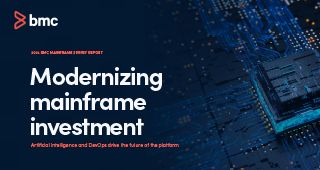What if the headlines haven’t caught up to reality? For the past several years, an impending demographic shift has been a hot topic of discussion in mainframe circles. The issue at hand: as seasoned mainframe professionals approach retirement age, next-generation talent arrives to take their place—and the world of the database and its DBAs is no different. And those retiring are taking decades of experience and institutional knowledge with them, creating a skills gap that mainframe organizations around the world and across industries will have to deal with in the near future.
Results of the 2023 BMC Mainframe Survey indicate that the future may already be here and, thanks to modern mainframe technology, the situation may not be nearly as dire as predicted. Only eight percent of respondents to this year’s survey identify as part of the “Baby Boomer” generation (those born from 1946 to 1964), while an identical eight percent identify as “Gen Z” (born between 1997 and 2012).
With the future demographic shift becoming a present reality, how can mainframe organizations bridge the skills gap between seasoned veterans and newcomers to the platform, while also getting the next generation of mainframe stewards up to speed faster and preserving institutional knowledge? I have one word for you—automation.
By leveraging automation, especially of mundane and time-consuming tasks, organizations can streamline operations, maintain consistent performance, and enable less-experienced mainframe professionals to focus on learning essential skills—all at the same time. In short, automation makes your organization faster while increasing opportunities for retiring professionals to mentor and pass along business-critical knowledge to the new generation.
Automating data management
Mainframe data management is an excellent example of an area where automation can make a significant difference. Traditionally, as developers worked on new applications, they had to stop coding and enter a change management request for each new database or schema change required by the application. These change requests were in turn handled by database teams that manually approved and executed each change.
Modern continuous integration and continuous delivery (CI/CD) pipelines streamline the process with automated database change management requests, approvals, and changes. Instead of relying on an individual to evaluate each request, this process codifies existing rules, thus preserving institutional knowledge, and evaluates requests against them, reducing dependency on workforce expertise and ensuring that database changes will not delay delivery of new applications.
Intelligent database reorganization
As mainframe workloads increase, so does the volume of data accessed on the platform. In the past, organizations relied on database experts to ensure that everything ran smoothly. With less-experienced professionals taking on these roles and databases becoming more fragmented at a faster rate, disorganized data can cause significant delays within application performance, consume expensive MIPS, and may even cause an outage to reorganize the data.
The Reorg Advisor in BMC AMI Apptune for Db2® (part of BMC AMI SQL Performance for Db2®) helps database administrators (DBAs) avoid these delays by notifying BMC AMI Utility Manager for Db2 of detected application degradations. BMC AMI Utility Manager for Db2® can then initiate reorganizations (reorgs) as needed, instead of relying on scheduled reorgs that may or may not improve application performance. Once the reorg is completed, BMC AMI Apptune for Db2® provides feedback on whether, and by how much, application performance was affected.
This automated review of performance eliminates guesswork from the reorg process and avoids the need for specialized knowledge of particular databases that may require more frequent reorgs while also avoiding the cost of unnecessary reorgs.
Measuring the advantage
While automated mainframe data management can bridge skills gaps and lead to significant cost savings and application performance improvements, database and application development managers will always be looking for ways to improve their processes. A series of dashboards in BMC AMI zAdviser provides insight into how performance has improved, as well as areas that may need more work. as well as areas that may need more work.
The Change Manager for Db2 dashboard enables managers to make evidence-based decisions to continuously improve the delivery of database schema changes and reduce rollbacks, with information on evaluated and modified objects, the number of work IDs completed, duration from creation to completion, and more. Using this dashboard, managers can see how work gets spread out on a daily basis, time spent to complete tasks, and which tools are being utilized or under-utilized, enabling them to identify areas to improve and establish baselines to help measure progress.
Included in our October release of BMC AMI enhancements, a set of new dashboards provide usage information for BMC AMI Data Utilities for Db2®, showing how many total utilities have run, how many users are running the utilities, and which utilities are spending the most and least CPU time, as well as the numbers of indexes and tables that have been processed and zIIP usage for each utility. New Copy and Recover dashboards give users even further insight, showing utilities executed, objects processed and the number of copies and recoveries, as well as longest time to recover and average time to recover.
These dashboards give managers detailed information on how and when BMC solutions are being used, enabling them to fine-tune how their teams work and make that work more efficient.
Preparing for the future—and the present
Mainframe workforce demographics are shifting before our very eyes. While replacing retiring DBAs and the knowledge they’ve gained from spending decades on the platform can seem daunting, there are ways to make this change your advantage and improve upon the present state while also preparing for future changes.
As the automation of mainframe data management shows, organizations can reduce costs, improve application performance, and enable new mainframe professionals to make an immediate difference. Take this opportunity to improve efficiency, speed delivery of new features, and codify the knowledge of a retiring generation, continuously building a better, more modern mainframe for generations to come.
Read this BMC Community post to learn more about all of the BMC AMI Data for Db2® enhancements included in our October release.






